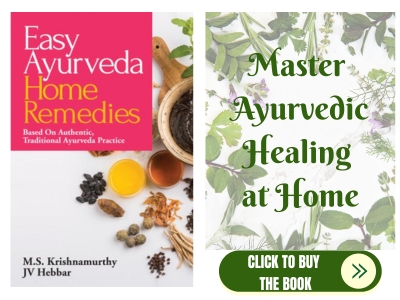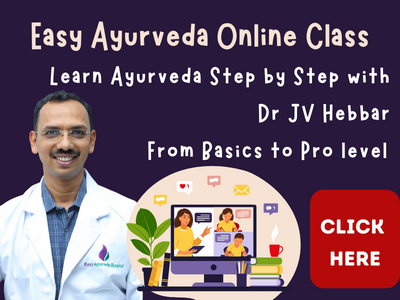Sushruta Samhita Sutrasthana Chapter 18: Vrana Lepana Bandhana Vidhi Adhyaya (Poulticing and Bandaging of Wounds)
The 18th chapter of Sutrasthana of Sushruta Samhita is named as Vrana Lepana Bandhana Vidhi Adhyaya. This chapter deals with the information Poulticing and Bandaging of Wounds.
अथातो व्रणालेपनबन्धविधिमध्यायं व्याख्यास्याम ः ॥१॥
यथोवाच भगवान् धन्वतरिः ॥२॥
We will now expound the chapter by name “Vranalepana Bandhana vidhi” – poultice and bandaging of wounds as revealed by venerable Dhanvantari.
Table of Contents
Importance of Alepa (Application of anointment / poultice) and Bandha (bandaging)
आलेप आद्य उपक्रमः, एष सर्वशोफानां सामान्यः प्रधानतमश्च, तं च प्रतिरोगं वक्ष्यामः । ततो बन्धः प्रधानं तेन शुद्धिर्व्रणरोपणमस्थिसंधिस्थैर्यं च ॥३॥
Alepa means administration of anointment or application of medicinal pastes on the wounds. This is the first treatment and is also a common (treatment) for all kinds of swellings. It is also said to be pradhanatama – the most important one. Alepas are different for different diseases and they will be separately described contextually, for each disease.
Following Alepa, Bandha i.e. bandaging is the important treatment. This causes cleansing of the wounds, healing wounds and establishes the stability of bones and joints.
तत्र प्रतिलोममालिम्पेत् । प्रतिलोमे हि सम्यगौषधमवतिष्ठतेऽनुप्रविशति च रोमकूपान् स्वेदवाहिभिश्च सिरामुखैर्वीर्यं प्राप्रोति ।४॥
Method of doing alepa – Alepa should always be done from below upwards i.e., in the upward direction. This is known as the pratiloma way. The medicines or medicinal pastes smeared while doing alepa, would stay properly on the wound only when done in pratiloma way. The medicines would also enter into the hair follicles, pores and sweat channels and get vitalized by the openings of the veins.
न च शुष्यमाणमुपेक्षेत, अन्यन्न पीडयितव्यत् शुष्को ह्यपार्थको रूक्करश्च ॥५॥
Once the alepa gets dried, it shall be quickly removed. The dried anointments should not be neglected and allowed to stay on the surface of the body. This is because, the dried anointment or poultice which has been left out without removing becomes therapeutically useless and would also cause pain and discomfort. It shall be left only when the intention of alepa is to squeeze the swelling.
Alepa Bheda: Kinds of poultices
स त्रिविधः- प्रलेपः, प्रदेह, आलेपश्च। प्रलेपप्रदेहयोरन्तरं -तत्र प्रलेपः शीतस्त- नुरविशोषी विशोषी वा; प्रदेहस्तूष्णः शीतो वा बहलोऽबहुरविशोषी च; मध्यमोऽत्रालेपः । तत्र, रक्तपित्तप्रसादकृदालेपः ; प्रदेहो वातश्लेष्पप्रशमनः शोधनो रोपणः शोफवेदनापहश्च, तस्योपयोगः क्षताक्षतेषु; यस्तु क्षतेषूपयुज्यते स भूयः ’कल्क’ इति संज्ञां लभते निरुद्धाऽलेपनसंज्ञः, तेनास्त्रावसन्निरोधो मृदुता पूतिमांसापकर्षणमनन्तर्दोषता व्रणशूद्धिश्च भवति ॥६॥
Alepa is of three kinds’
– Pralepa,
– Pradeha and
– Alepa
Below mentioned are the differences between pralepa and pradeha –
– pralepa is applied cold, thin, is either of not drying up or drying type, while
– pradeha is applied either warm or cold, thick or thin and ‘not drying up’ type
– alepa is the middle of these two (intermediate) and it mitigates (balances) aggravated blood and Pitta
Pradeha, apart from mitigating the aggravated vata and kapha, would also cause cleansing of the wounds. It would also relieve swelling and pain. It is useful in both conditions – swelling with wound (ulcer) and swelling without wound.
That which is used in wounds / injury is known as kalka (paste or wick). It is also known as niruddhalepana. This will help in arresting the discharges (stopping the exudation), bringing softness, destruction of decayed (suppurated) muscles, and removal of doshas from within the wound (ulcer) and cleansing of the wounds (ulcer).
Alepa Phala: Benefits of anointing
अविगग्धेषु शोफेषु हितमालेपनं भवेत्।
यथास्वं दोषशमनं दाहकण्डूरूजापहम् ॥७॥
त्वक्प्रसादनमेवाग्य्रं मांसरक्तप्रसादनम् ।
दाहप्रशमनं श्रेष्ठं रुजाकण्डूविनाशनम् ॥८॥
मर्मदेशेषु ये रोगा गृह्येष्वपि तथा नृणाम् ।
संशोधनाय तेषां हि कुर्यादालेपनंभिषक् ॥९॥
(षड्भागं पैत्तिके स्नेहं चतुर्भागं तु वातिके।
अष्टभागं तु कफजे स्नेहमात्रां प्रदापयेत् ॥१०॥
Alepana means application of herbal pastes. It also includes application in the form of poultice. This procedure is beneficial in the treatment of ama sopha i.e. unripe swellings.
Other benefits of alepa includes –
– it mitigates the doshas associated (and causing) the swellings
– relieves burning sensation, itching and pain associated with swelling,
– it is the most important and foremost approach in clearing and soothing the skin, muscles and blood and also removing the blemishes
– it is the best in relieving burning sensation, pricking pain and itching,
Alepana can also be used to cleanse or palliate the diseases occurring in the vital spots of the body or genital areas.
In pittaja diseases (swelling in this context), oil, ghee etc. fats should be added to the alepa in one sixth proportion.
Similarly, in vataja diseases / swellings, the fats should be added in one fourth proportions of alepa.
One eighth portion of fats should be added for alepa in case of swellings caused by kapha.
Alepa Vidhi: Procedure
तस्य प्रमाणं महिषार्द्रचर्मोत्सेधमुपदिशन्ति ॥११॥
न चालेपं रात्रौ प्रयुञ्जीत, माभूच्छैत्यपिहतोष्मणस्तदनिर्गमाद्विकारप्रवृतिरिति॥१२॥
प्रदेहसाध्ये व्याधौ तु हितमालेपनं दिवा।
पित्तरक्ताभिधातोत्थे सविषे च विशेषतः ॥१३॥
न च पूर्युषितं लेपंकदाचिदवचारयेत् ।
उपर्युपरि लेपं च न कदाचित प्रदापयेत् ॥१४॥
ऊष्माणं वेदनां दाहं घनत्वाज्जनयेत् स हि ।
न च तेनैव लेपेन प्रदेहं दापयेत् पुनः ।
शुष्कभावात्स निर्वीर्यो युक्तोऽपि स्यादपार्थकः ॥१५॥
The thickness of alepa should be equal to the thickness of the moist buffalo hide (skin) which is approximately 0.25 cm.
Alepa, as a rule, should not be applied at night. This is because if alepa is applied at night, the cold of the night would cloud or obstruct the heat of the swelling. This would eventually give rise to many abnormalities. The disease and its symptoms would increase and many new complications would manifest.
In diseases which are curable by Pradeha (warm anointment) and mainly in diseases caused due to increased pitta, blood or raktapitta – bleeding disorders, diseases caused due to injury and effect of poisons it is beneficial to apply the medicinal pastes (anointment) in the morning.
The medicinal paste which has been prepared on the previous day should not be administered on the next day (i.e. the medicinal paste should be prepared fresh every day and should not be carried over).
Similarly, the second layer of anointing should not be administered on the previously existing layer of anointment (on the afflicted part of the body). This means to tell that the anointment which has been applied previously should be removed before administering the fresh layer of anointment. By doing so (one layer of anointment applied over a pre-existing one) the thickness of the anointment increases. This gives rise to increased heat, pain and burning sensation (in the affected site).
The medicinal paste left out after applying the anointment should not be used for anointing (applying poultice) once again because the left out medicine would have dried out and have lost its potency. Even if this is applied it does not serve any purpose.
Bandhana Dravya: Bandaging Material
अत ऊर्ध्वं व्रणन्धनद्रव्याण्युपदेक्ष्यामः ; तद्यथा, क्षौमकार्पासाविकदुकूलकौशेयपत्रोर्णचीनपट्टचर्मान्तर्वल्कलालाबूशकललताविदलरज्जुतूलफलसन्तानिकालौहानीति; तेषां व्याधिं कालं चावेक्ष्योपयोगः ’ प्रकरणतश्चैषामादेशः ॥१६॥
Now, the materials useful for bandaging will be described. They include –
– kshauma – flax
– karpasa – cotton
– avika – wool of sheep
– dukula – very fine cloth piece or raiment made from the inner bark of this plant
– kauseya – silk
– patrorna – garment prepared from woven silk
– cinapatra – cloth made in China, silk cloth
– carma – hide
– antarvalkala – inner layers of barks
– alabusakala – pieces of alabu – gourd
– lata – creeper
– vidala – split bamboo
– rajju – rope
– tulaphala santanika – a pad which is prepared from wool extracted from silk cotton fruit
– metals – example – sheets of silver, copper, iron etc.
These substances mentioned above should be used as and when needed and as appropriate in particular diseases and also in relation to time / season etc. The mention of the above said bandaging materials will be made with reference to the context, diseases, place etc.
Bandha Vishesha: Patterns of Bandaging
तत्र कोशदामस्वस्तिकानुवेल्लितमु (प्र) तोलीमण्डलस्थगिकायमकखट्वाचीनविबन्धवितानगोफणाः पञ्चाङ्गी चेति चतुर्दश बन्धविशेषाः । तेषां नामभिरेवाकृतयः प्रयेण व्याख्याताः ॥१७॥
Bandha Visesa – Below mentioned are fourteen kinds of / patterns of bandaging –
1. Kosa,
2. Dama,
3. Svastika,
4. Anuvellita,
5. Mutoli (or pratoli),
6. Madala,
7. Sthagika,
8. Yamaka,
9. Khatva,
10. Cina,
11. Vibandha,
12. Vitana,
13. Gophaa and
14. Pancangi,
Their shapes are generally implied in their names itself.
Uses of different kinds of bandhas
तत्र कोशमङ्गुष्ठाङ्गुलिपर्वसु विदध्यात्, दाम, संबाधेऽङ्गे, सन्धिकूर्चकभूस्तनान्तरतलकर्णोषु, स्वस्तिकम्, अनुवेल्लितं शाखासु, ग्रीवामेढ्रयो ः मु(प्र) तोलीं वृत्तेऽङ्गे मण्डलम्, अङ्गष्ठाङ्गुलिमेढ्राग्रेषु स्थागिकां, यमलव्रणयोर्यमकं, हनुशङ्खगण्डेषु खटवाम्, अपङ्गयोश्चीनं, पृष्ठोदरोरःसु विबन्धं, मूर्धनि वितानं, चिबुकनासौष्ठांसबस्तिषु गोफणां, जत्रुणऊर्ध्वं पञ्चाङ्गीमिति; यो वायस्मिन् शरीरप्रदेशे सुनिविष्टो भवति तं तस्मिन विदध्यात् ॥१८॥
| Name of the Bandha (bandage) | Shape of the bandage / meaning | Area of usage |
| Kosa | cocoon – like sac, envelop, scabbard | should be used for the joints of thumb and fingers |
| Dama | wound round like a belt | for the part of the body which has pain or cramps |
| Svastika | cruciform, like plus mark | for the joints, kurcaka (area over metatarsals), between the brows, between the breasts, palms, soles and ears |
| Anuvellita | bent underneath, twisted, | for the extremities |
| Mutoli (pratoli) | broad, winding | for the neck and penis |
| Mandala | round, disc, like, ring like, circular | for parts of the body which are round/cylindrical |
| Sthagika | to conceal / heal, stump like | for the tips of the thumbs, fingers and penis |
| Yamaka | twin, double, with two fold / parts | for two wounds side by side |
| Khatva | swigs, hammock like | for the lower jaw, temples and cheeks |
| Cina | thread like T shaped | for the outer canthus of eyes |
| Vibandha | obstructive, biding from both sides | for the back, abdomen and chest |
| Vitana | tent like, canopy like | for the head (scalp) |
| Gophana | like horns of the cow | for the chin, nose, lips, shoulders, and urinary bladder |
| Pancangi | with five parts, five tailed | for part / organs above the shoulders |
Or the physician may use any pattern or method of bandage which is well suited and gets well placed (sitting tight and right) on the affected part and apply it accordingly.
Bandha Niyantraa: Tightening the bandage
यन्त्रणमूर्ध्वमधस्तिर्यक् च ॥१९॥
Yantrana which actually means to control, in this context, means to tighten or put knots so as to keep the bandage in place. Yantrana may be done at three places i.e. above, below and by the sides of the wound.
Bandha vidhi: Procedure of tying bandage
तत्र घनांकवलिकां दन्त्वा वामहस्तपरिक्षेपमृजुमनाविद्धमसंकुचितं मृदु पट्टं निवेश्यबध्नीयात् । न च व्रणस्योपरि कुर्याद्वन्तिमाबाधकरं च ॥२०॥
First of all, a thick kavalika i.e. wick or a roll made up of medicinal paste should be kept on the wound. Following this, a bandage should be properly tied by moving it in the direction of the left hand in such a way that the bandage is held in the left hand and tied with the right hand. Bandaging should be tied straight, without folding and without any complicated twists. It should be tied in a proper way and by inserting a soft pad of cotton cloth or gauze. Care should be taken that the knot of the bandage should not be tied on the wound. If done, it causes severe pain.
न च विकेशिकौषधे अतिस्निग्धे अतिरूक्षे विषमे वा कुर्वीत; यस्मादतिस्नेहात् क्लेदो, रौक्ष्याच्छेदो, दुर्न्यासाद्भणवर्त्मावघर्षणमिति ॥२१॥
Vikesika (wick) and Aushada (medicine or paste of drugs) i.e. paste of drugs applied on a band of cloth or threads which is rolled and made like a wick – should be neither very unctuous nor very dry, or uneven (irregular).
There are reasons for this –
– ati snigdha – too much unctuousness produces more discharges / exudates
– ati ruksha – too much of dryness produces tearing
– vishama – when it is kept irregularly, it causes friction on the wound and at the wound edges
Trividha Bandha: Three kinds of tying
तत्र व्रणायतनविशोषाद्वन्धविशेषस्न्निविधो भवति- गाढः, समः, शिथिल इति ॥२२॥
पीडयत्ररुजो गाढः; सोच्छ् वासः शिथिलःस्मृतः ।
नैव गाढो न शिथिलः बन्धः प्रकीर्तितः ॥२३॥
Bandaging is basically of three types depending on the location of the wound. They are –
– Gadha – tight
– Sama – even or moderate and
– Sithila – loose
Tight bandaging is that which though tied firmly or pressed does not cause any pain. Loose bandaging is that which exhales (allows movements of air from inside) / moves when the person breathes (exhales). Even bandaging (moderate) is that which is neither too tight nor too loose.
Areas of the body where three types of bandaging should be done
तत्र स्फिक्कुक्षिकक्षावङ्क्षणोरूशिरः सु गाढः , शाखावदनकर्णकण्ठमेढ्रमुष्कपृष्ठपार्श्वोदरोरः सु समः अक्ष्णोः सन्धिषु च शिथिल इति॥२४॥
| Type of Bandaging | Where to do? |
| Gadha – tight | Butts Pit of abdomen Axillae Groins Thighs Head |
| Sama – even, moderate | Extremities Face Ears Throat Penis Scrotum Back Flank Abdomen Chest |
| Sithila – loose | Eyes Bony joints |
तत्र पैत्तिकं गाढस्थाने समं बघ्नीयात्,समस्थाने, शिथिलं, शिथिलस्थाने नैव; एवं शोणितदुष्टं च; श्लैष्मिकंशिथिलस्थाने गाढं, गाढस्थाने गाढतरम्; एवं वातदुष्टं च ॥२५॥
In wound of Pitta origin and also diseases caused by vitiation of Rakta – blood,
– If the wound is located on places of the body indicated for tight banding, then the physician should do a moderate kind of bandaging instead of tight bandaging.
– Similarly, if the wound is situated in places of even (moderate) bandaging then loose bandaging should be done.
– If the wound is situated on places meant for loose bandaging, no bandaging should be done i.e. the wound should be left open.
In case of wounds caused by predominant aggravation of kapha or even by aggravated vata,
If the wound is situated on places meant for loose bandaging, then moderate bandaging should be done.
– If the wound is situated in places meant for even or moderate bandaging then tight bandaging should be done.
– If the wound is situated on places meant for tight bandaging, then tighter bandaging should be done.
Bandhana Kala: Frequency of Bandaging
तत्र पैत्तिकं शरदि ग्रीष्मे द्विरह्नो बध्नीयात् , रक्तोपद्रुतमप्येवं ; श्लैष्मिल् हेमन्तवसन्तयोस्त्रहात्, वातोपद्रुतमप्येवम। एवमभ्यूह्य बन्धविपर्ययं च कुर्यात् ॥२३॥
तत्र, समशिथिलस्थानेषु गाढं बद्धे विकेशिकौषधनैरर्थक्यं शोफवेदनाप्रादुर्भावश्च, गाढसमस्थानेषु शिथिलं बद्धे विकेशिकौषपतनं पट्टसंचाराद्वणवर्त्मावघर्षणमिति; गाढशिथिलस्थानेषु समं बद्धे गुणाभाव इति ॥२७॥
Bandaging should be done twice a day, in the below mentioned conditions –
– In pitta diseases
– In sharad rtu – autumn and grishma rtu – summer seasons
– In diseases produced by vitiated / aggravated blood
Bandaging should be done once in three days, in the below mentioned conditions –
– In kapha diseases
– In hemanta rtu – early winter and Vasanta rtu – spring seasons,
– In vata diseases
In this way, the suitable time of bandaging should be decided by the physician by his own intelligence.
The medicine (drug) inside the wick of paste used for application over the wound becomes wasted and there will also be manifestation of swelling and pain if the physician applies tight bandaging in places of the body indicated for moderate or loose bandaging.
On the other hand, the medicine inside the wick will fall off and there will also be damage to the wound edges due to friction caused due to the movement of the cloth and drug, if the physician applies loose bandaging on places of the body indicated for tight or moderate bandaging.
There will absolutely be no effect of bandaging if the physician applies a moderate kind of binding / bandaging on places of the body indicated for tight or loose bandaging.
अविपरीतबन्धे वेदनोपशान्तिरसृकप्रसादो मार्दवं च ॥२८॥
Bandaging will bestow the below mentioned benefits if it is applied in the above said manner –
– Relief from pain
– Purification of blood
– Softness of the wound
Bandha Abhava: Absence of Bandaging
अबध्यमानो दंशमशकतृणकाष्ठोपलपांशुशीतवातातपप्रभृतिभिर्विशेषैरभिहन्यतेव्रणः, विविधवेदनोपद्रुतश्च दुष्टतामुपैति, आलेपनादीनि चास्य विशोषमुपयान्ति ॥२९॥
Below mentioned are the effects of not applying the bandage when it needs to be –
– the wound would get exposed to the bite of flies, grass, wood pieces, stone pebbles, sand, cold, wind, sunlight etc. external factors / things and would consequently get troubled
– development of many kinds of pains and complications
– contamination / vitiation of wound
– very quick drying of anointments (medicinal pastes), poultices etc.
Bandha Guna: Benefits of Bandaging
चूर्णितं मथितं भग्रं विश्लिष्टमतिपातितम् ।
अस्थिस्नायुसिराच्छिन्नमाशु बन्धेन रोहति ॥३०॥
सुखमेवं व्रणी शेते गच्छति तिष्ठति ॥
सुखं शय्यासनस्थस्य क्षिप्रं संरोहति व्रणः ॥३१॥
Below mentioned are the benefits of bandaging –
– crushed and lacerated wounds get healed quickly
– fractures, dislocation of joints, free hanging and torn bones (due to fracture or dislocation) get cured quickly
– faster healing of injury to tendons, veins etc.
– the wounded person will find it easy to sit, walk, stand and lie down
– quick healing of wounds
Abhandhya: Contraindications for bandaging
अबन्ध्याः पित्तरक्ताभिघातविषनिमित्ता यदा शोफदाहपकरागतोदवेदनाभिभूताः क्षाराग्रिदग्धाः पाकात् प्रकथितप्रशीर्णमांसाश्च भवन्ति॥३२॥
Bandaging should not be done on wounds caused by –
– vitiated Pitta and rakta (blood),
– injury and poison,
– when accompanied with edema, burning sensation, pus formation (suppuration), red coloration, pain and such troubles,
– wounds caused by alkali and fire,
– when the muscles of the wound are decomposed and falls off
Other contraindications for bandaging
कुष्ठिनामग्रिदग्धानां पिडका मधुमोहिनाम् ।
कर्णिकाश्चोन्दुरुविषे विषजुष्टाश्च ये व्रणाः ॥३३॥
मांसपाके न बध्यन्ते गुदपाके च दारुणे ।
स्वबुद्ध्चा चापि विभजेत्कृत्याकृत्यांश्च बुद्धिमान् ॥३४॥
देशं दोषं च विज्ञाय व्रणं च व्रणकोविद ः ।
ऋतूंश्च परिसंखाय ततो बन्धान्निदेशयेत् ॥३५॥
Bandaging should also not be done in the below mentioned conditions –
– wounds of leprosy,
– wounds caused by fire burns,
– ulcers / wounds caused by the spread of poison caused by rat bite,
– wounds / ulcers caused or associated with poison (having poison in them)
– wounds caused by suppuration of muscles (gangrene) and
– (severe) ulceration / suppuration of the rectum
The intelligent physician alone should make a wise decision so as to apply the bandage or not. Those specialized in treating the wounds should also decide to do bandaging only after considering the nature of habitat, doshas and seasons.
Sangraha Sloka: Summarising verses
ऊर्ध्वं तिर्यगधस्ताच्च यन्त्रणा त्रिविधा स्मृता॥
यथा च बध्यते बन्धस्तथा वक्ष्याम्यशेषतः ॥३६॥
घनां कवलिकां दत्वा मृदु चैवापि पट्टकम् ।
विकेशिकामौषधंच नातिस्निग्धं समाचरेत् ॥३७॥
प्रक्लेदयत्यतिस्निग्धा तथा रूथा क्षिणोतिच ॥
युक्तस्नोहा रोपयति दुर्न्तस्ता वर्त्म घर्षति॥३८॥
विषमं च व्रणं कुर्यात् स्तम्भयेत् स्त्रावयेत्तथा।
यथाव्रणं विदित्वा तु योगं वैद्यः प्रयिजयेत् ॥३९॥
पित्तजे रक्तजे वाऽपि सकृदेव परिक्षिपेत्।
असकृत् कफजे वाऽपिवातजे च विचक्षणः ॥४०॥
तलेन प्रतिपीड्चाथ स्त्रावयेदनुलोमतः ॥
सर्वंश्च बन्धना गूढान्तान् सर्न्धींश्च विनिवेशयेत्॥४१॥
ओष्ठस्याप्येष सन्धाने यथोद्दिष्टो विधिः स्मृतः ॥
बुद्द्चोत्प्रेक्ष्याभियुक्तेन तथा चास्थिषु जानता ॥४२॥
उत्तिष्टिहतो निषण्णस्य शयनं चाधिगच्छतः ॥
गच्छतो विविधैर्यानैर्नास्य दृष्यतिस व्रणः ॥४३॥
ये च स्युर्मांससंस्था वै त्वग्गताश्च तथा व्रणाः ॥
सन्ध्यस्थिकोष्ठप्राप्ताश्च सिरास्नायुगतास्तथा॥४४॥
तथाऽवगाढगम्भीराः सर्वतो विषमस्थिताः ॥
नैते साधयितुं शक्या ऋते बन्धाद्भवन्ति हि ॥४५॥
Yantrana – means bandage knot or applying the bandage by tying knot. It is of three types. They are –
– urdhwa – above,
– tiryak – at the sides and
– adhah – below (the wound)
Now, the procedure of bandaging will be explained by me.
Firstly, a lint / wick is placed on the wound on which a layer of medicinal paste is applied (anointed). On this, a thick pad of cloth (gauze) is placed over the anointment and a soft bandage is tied on it.
The physician should take care that the medicinal paste inside the wick should neither be very unctuous nor should it be dry. Very unctuous paste would cause discharges / exudation. On the other hand, very dry paste would cause abrasion of the wound edges.
The wick and the drugs with suitable unctuousness will help in healing of the wounds.
If the wick is not placed properly, it causes friction of the edges of the wound, makes the ulcer irregular in shape, causes obstruction to flow of discharges or increases the flow of discharges. Therefore, the physician should apply the wick of paste in a proper manner after having known (observing and examining) the nature of wounds.
In wounds produced by Pitta or Rakta the wick should be applied once only and in wounds of Kapha and vata origin, it may be applied many times. The wound should be pressed / squeezed with the palm of the hand (of the physician) from above downwards to discharge the exudates from the wound. All kinds of bandages should be tied such that its ends or knot are not seen from outside i.e. they should be tied appropriately.
The same procedure is followed even for joining the damaged lips. Bandaging in these conditions should be done with discretion and good knowledge. With this the wound will not get contaminated (or will not cause any trouble) while getting up, lying down, sleeping, walking or riding on different kinds of animals.
Below mentioned kinds of wounds will not get cured without suitable bandaging –
– wounds located on the muscles, skin, joints, bone, alimentary tract (visceral organs), veins, ligaments etc.
– superficial wounds
– deep wounds
– all kinds of uneven or irregular wounds
इति श्रीसुश्रुतसंहितायां सूत्रस्थाने व्रणालेनबन्धविधिर्नामाष्टादशोऽध्यायः ॥१८॥
Thus ends the eighteenth chapter, by the name Vranalepana Bandhana vidhi in Sutra Sthana of Susruta Samhita.









